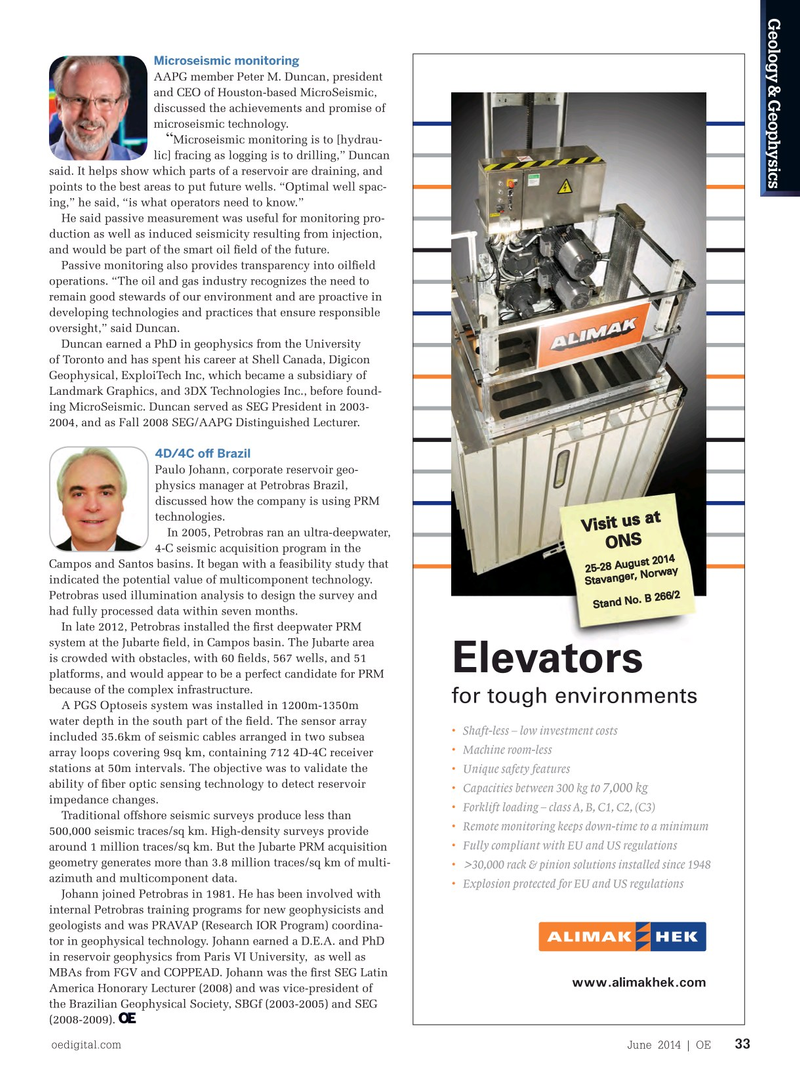
Page 31: of Offshore Engineer Magazine (Jun/Jul 2014)
Read this page in Pdf, Flash or Html5 edition of Jun/Jul 2014 Offshore Engineer Magazine
Geology & Geophysics
Microseismic monitoring
AAPG member Peter M. Duncan, president and CEO of Houston-based MicroSeismic, discussed the achievements and promise of microseismic technology. “
Microseismic monitoring is to [hydrau- lic] fracing as logging is to drilling,” Duncan said. It helps show which parts of a reservoir are draining, and points to the best areas to put future wells. “Optimal well spac- ing,” he said, “is what operators need to know.”
He said passive measurement was useful for monitoring pro- duction as well as induced seismicity resulting from injection, and would be part of the smart oil feld of the future.
Passive monitoring also provides transparency into oilfeld operations. “The oil and gas industry recognizes the need to remain good stewards of our environment and are proactive in received Shell’s 1991 President’s Award. He recently formed developing technologies and practices that ensure responsible
Omoted Geophysical Consulting. Detomo has served SEG oversight,” said Duncan.
in many capacities, as technical program chair for the 2006 Duncan earned a PhD in geophysics from the University
Annual Meeting, Chair of the Travel Grants Committee, Trustee of Toronto and has spent his career at Shell Canada, Digicon
Associate of the SEG Foundation, and travelled as the SEG 2012 Geophysical, ExploiTech Inc, which became a subsidiary of
Honorary Lecturer in the Middle East & Africa, discussing 4D Landmark Graphics, and 3DX Technologies Inc., before found- time-lapse reservoir monitoring. Detomo is Vice-Chair of the ing MicroSeismic. Duncan served as SEG President in 2003-
SEG subcommittee for the OTC 2015 technical program. 2004, and as Fall 2008 SEG/AAPG Distinguished Lecturer.
Seabed hardware 4D/4C of Brazil
Shuki Ronen, Seabed Geosolutions BV, Paulo Johann, corporate reservoir geo- questioned whether PRM is the future of physics manager at Petrobras Brazil, reservoir geophysics. discussed how the company is using PRM
Non-permanent technology, including technologies.
Visit us at streamers and ocean-bottom nodes, can also In 2005, Petrobras ran an ultra-deepwater,
ONS provide proper reservoir monitoring, espe- 4-C seismic acquisition program in the cially with faster shooting and better broadband sources. Campos and Santos basins. It began with a feasibility study that 25-28 August 2014
Sometimes it is a good idea to put receivers on the seabed; indicated the potential value of multicomponent technology.
Stavanger, Norway sometimes it is not, Ronen has said. “I want to encourage Petrobras used illumination analysis to design the survey and
Stand No. B 266/2 people to know where and when and how to put seismic receiv- had fully processed data within seven months.
ers on the bottom of the ocean.” In late 2012, Petrobras installed the frst deepwater PRM 4D reservoir monitoring often requires seismic surveil- system at the Jubarte feld, in Campos basin. The Jubarte area lance in congested offshore areas, where obstacles deter full is crowded with obstacles, with 60 felds, 567 wells, and 51
Elevators streamer spreads. Ronen points out that seabed receivers platforms, and would appear to be a perfect candidate for PRM present fewer safety challenges than surface-towed stream- because of the complex infrastructure.
for tough environments ers. Permanent or accurately repositioned receivers also have A PGS Optoseis system was installed in 1200m-1350m improved repeatability for reservoir production monitoring. water depth in the south part of the feld. The sensor array • Shaft-less — low investment costs
Ronen anticipates more remotely operated vehicle-enabled included 35.6km of seismic cables arranged in two subsea • Machine room-less installations and longer battery life. array loops covering 9sq km, containing 712 4D-4C receiver
In addition to improved P-wave imaging, multicomponent stations at 50m intervals. The objective was to validate the • Unique safety features seabed receivers record shear waves, which can help distin- ability of fber optic sensing technology to detect reservoir • Capacities between 300 kg to 7,000 kg guish between effects of fuid change and pore-pressure change. impedance changes.
• Forklift loading — class A, B, C1, C2, (C3)
Ronen earned a PhD in geophysics at Stanford University Traditional offshore seismic surveys produce less than • Remote monitoring keeps down-time to a minimum and works in academia and the oil industry. He was a visit- 500,000 seismic traces/sq km. High-density surveys provide • Fully compliant with EU and US regulations ing professor at Colorado School of Mines, and has been a around 1 million traces/sq km. But the Jubarte PRM acquisition consulting faculty member at Stanford since 2008. He worked geometry generates more than 3.8 million traces/sq km of multi- • 30,000 rack & pinion solutions installed since 1948 > at Saxpy Computer, Schlumberger and Veritas DGC in various azimuth and multicomponent data. • Explosion protected for EU and US regulations positions for 18 years, before consulting for Chevron, joining Johann joined Petrobras in 1981. He has been involved with
Seabird, and then serving as Vice President for Ocean Bottom internal Petrobras training programs for new geophysicists and
Technology at CGGVeritas. Ronen is now Chief Geophysicist geologists and was PRAVAP (Research IOR Program) coordina- at Seabed Geosolutions (JV between Fugro and CGG). He tor in geophysical technology. Johann earned a D.E.A. and PhD received an SEG Special Commendation in 2002, recognized in reservoir geophysics from Paris VI University, as well as as one of the four principal developers of Seismic Un*x, and MBAs from FGV and COPPEAD. Johann was the frst SEG Latin www.alimakhek.com in 2012 served as SEG North America Honorary Lecturer, America Honorary Lecturer (2008) and was vice-president of discussing “Ocean-bottom acquisition and processing: past, the Brazilian Geophysical Society, SBGf (2003-2005) and SEG present, and future.” (2008-2009). oedigital.com June 2014 | OE 33 000_OE0614_G&G1.indd 33 5/22/14 9:51 PM

 30
30

 32
32